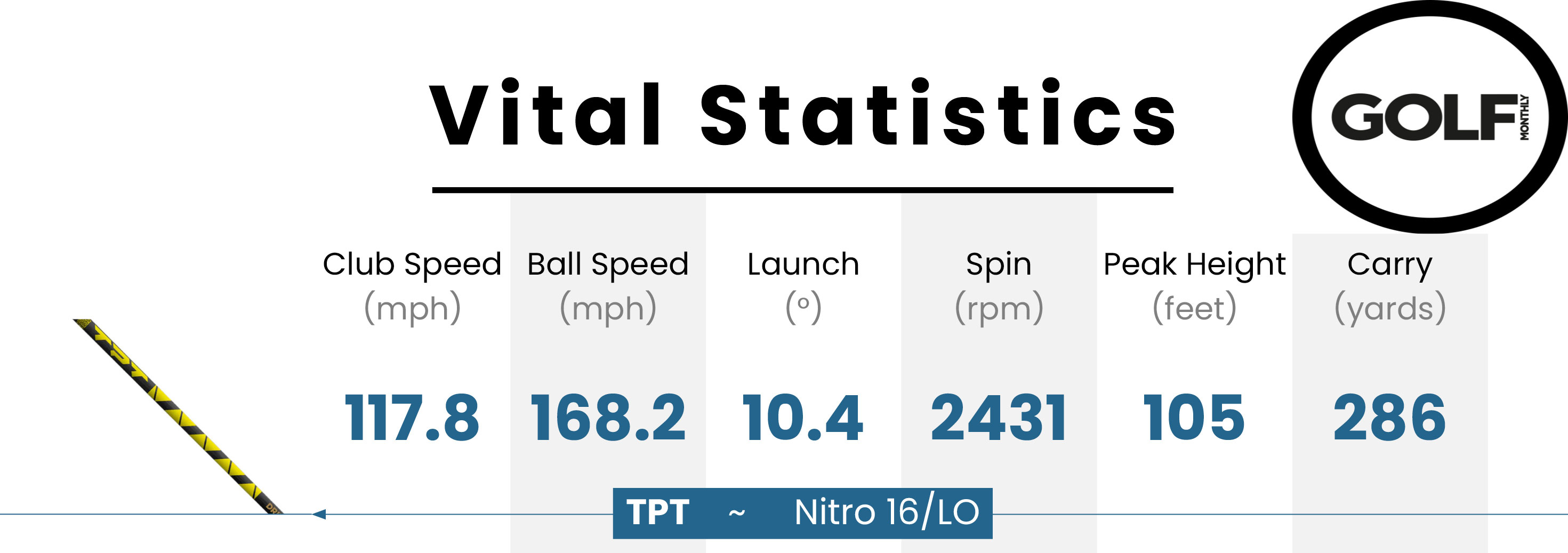TPT Golf has established itself in the premium shaft market by utilizing a revolutionary automated manufacturing process that prioritizes consistency above all else.
Its latest offering, the TPT Nitro shaft, aims to deliver maximum stability and feel, and I was excited to put this shaft through its paces to see if its unique manufacturing process translates into the kind of tight dispersion every golfer dreams of.
How We Test Shafts

(Image credit: Future)
All of our shaft testing is conducted using the same TaylorMade Qi35 core head driver set to a precise 9 degrees (measured), with each shaft cut to an exact length of 45.5 inches, fitted with a Golf Pride Tour Velvet 60R grip. Furthermore, all testing shots are struck from a white castle tee to ensure consistent tee height during testing.
Best picks for you
The data is collected and recorded using a Foresight Sports GC3 launch monitor and TaylorMade TP5x golf balls .

(Image credit: Future)
Controlling these potential variables allows me to draw accurate and direct comparisons and form a clear picture of each shaft’s performance and feel characteristics.
TPT Nitro Shaft Review: Technology
The TPT Nitro distinguishes itself immediately in its construction. During the process of cutting and installing the adapter to my demo model, I immediately noticed how thin the shaft walls are compared to a competitor like the Fujikura Ventus.
TPT uses a unique automated process to continuously wind carbon fibers, eliminating the inconsistencies inherent in traditional roll-wrapping.

(Image credit: Future)
This method creates a perfectly uniform spine and manifests itself in the aforementioned ‘thinner-than-normal’ wall structure, which is the secret sauce behind the company’s stability claims.
For my testing, I tried the 16/LO shaft (a 65-gram shaft that translates to an S+ flex, sitting between stiff and X-stiff).
TPT Nitro Shaft Review: Performance
My first impressions when waggling the club pre-shot were great. I loved how responsive the shaft felt – not soft, just plenty of feel and feedback throughout, providing a really smooth and friendly feeling under the hands, suggesting a refined, uniform energy transfer.

(Image credit: Future)
In the swing, the Nitro continued to impress me. The feeling was the absolute counterpoint of harsh or boardy, and despite its relatively high stiffness rating, I could feel the load and unload happening in a seamless, fluid way.
The launch monitor numbers were very similar for me to the Fujikura VeloCore+ Ventus Blue shaft that I tested a few weeks ago, matching its high ball speed and launch window.
However, the standout feature of this shaft was its remarkable dispersion. While sometimes you can just stumble across a shaft that simply matches your delivery and all the moons and stars align, this is not an isolated finding with TPT for me.
I tested the previous iteration in my former life as a fitter and was equally blown away with the tight down-range dispersion of that shaft, too, suggesting something in the tech is very much doing its job. I typically operate at a dispersion average of around 15 yards, but with the TPT Nitro shaft it was down to 10 yards – a level I have not experienced before – with a much smaller standard deviation too.

(Image credit: Future)
I can’t fully explain it – I’m not intelligent enough to delve into the micro-manufacturing reasons this might be the case – but every single time I test a TPT product, I know it isn’t going to take me very long to collect my practice balls because they are generally right next to each other!
The consistent, repeatable nature of the manufacturing seems to translate directly into unparalleled accuracy down the fairway.
TPT Nitro Shaft Review: Verdict
The TPT Nitro shaft delivers a compelling combination of speed, feel, and stability that makes it a standout offering in the premium aftermarket shaft market, and make no mistake about it, it is premium, coming in at $650.
Its smooth, responsive profile and impressive speed output are only surpassed by its frankly ludicrous consistency. If you are a golfer looking to eliminate the wide miss and prioritize tight dispersion above all else, the TPT Nitro should be the very first shaft on your testing list.







